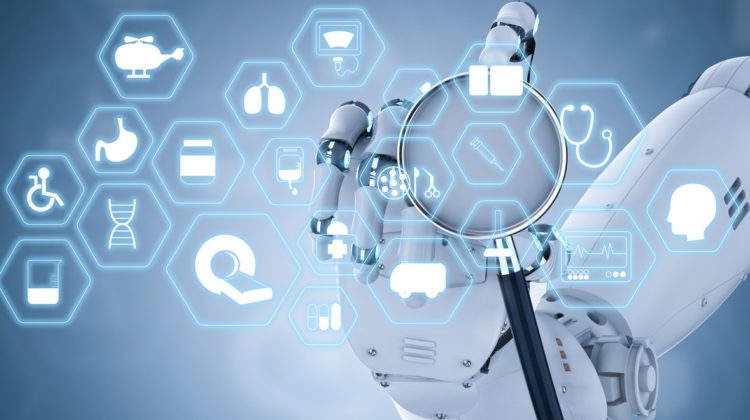
Artificial Intelligence is making rapid growth in different industries with the potential to change the way of delivering services with more accuracy and without the involvement of humans. There are several intelligent systems currently in use to make people’s lives easier. Similarly, the health industry is one of the fastest-growing industries around the globe. AI and the health industry can be joined to make great results in regard to treatment and other services such as patients care. AI can change the way of treating people in the hospital where a robot can do surgeries.
According to Strickland (2019), there are several artificial Intelligent applications in health care such as robotic surgery, image analysis, genetic analysis, pathology, etc. There are many success stories with robotic surgery in the industry. There are different robotic surgeons who are currently in use around the world to change the lives of people. Watson’s Robotic Surgeon is currently used for simple operations such as eye surgery and hair transplant. Robots are used to assist surgeons during the operation. Medical data doubles every 3 years and that data can be used to train the model that will be used in robots. These robots can analyze data and make decisions accordingly. There are limited hospitals where such robots are in use. Most of these robots are used for assistance. The number and type of surgeries that are done by robots are increasing day by day as many private and public hospitals are implementing the system. With the use of historical data and complex algorithms, AI can find hidden patterns that a human surgeon might not be able to find so that it can perform surgeries with higher accuracy and great precision. Machine learning algorithms are used for providing advice from historical data that is stored in the cloud. Deep Convolutional Neural Network (DCNNN) is used for creating multiple convolutional layers where the system can automatically learn from data. Reinforcement learning algorithms are used to transfer knowledge and policies with the human surgeon demonstrations. In this learning process, the robot as an agent tries to find the optimized policies that give highly accumulated rewards through iterative interaction with the surrounding environment (Zhou & Yang, 2019). Markov Decision Process (MDP) is used for modelling the reinforcement learning environment.
Robotic surgery has many benefits for both patients and surgeons. The robot can make decision-based on previous knowledge which helps to decide the correct procedure which will produce higher accuracy of surgery. In addition, the robot can work with smaller incisions with minimal pain which helps patients to recover quickly and reduces the time required to be hospitalized. The robot can handle a huge workload which means it can be available all the time. The risk of infection can be reduced while using robotic surgery as it does not include human interaction. AI is used to make better data-driven decisions. This can produce faster and more correct procedures with the reduction of human errors.
Although there are many benefits to robotic surgery, it also has many disadvantages. Firstly, the cost of operation is higher than in human-based surgery. It heavily depends on data that is used for training so there is a chance of making the wrong decision which can lead patients to death. Similarly, some of the patients might not be comfortable with robots as there is no touch sensation and it might create panic with patients. Robotic-assisted surgeries are longer to perform but blood loss is much reduced, and hospitalized time is decreased as well (S & Gotlieb, 2017). There are also some challenges to implement AI in robotic surgery as it is a very complex process. Firstly, data is the key to create a successful robot that can perform surgery and integration of data is complex. Similarly, there could be legal issues about data privacy where data that is used for designing a model could be violating the patient’s right to privacy. Also, understanding and adapting AI in the workplace could be challenging.
While there are several advantages and disadvantages with the use of robotic surgery, there are private and public hospitals, mostly private which are currently using robots for general surgery. AI is currently not taking the role of human base surgery while robots are assisting surgeons to achieve better results. The future of robotic surgery looks promising as many hospitals around the world are embracing the change and better algorithms are built with emerging technologies. There are ongoing development and improvement in robot systems for better results. AI techniques such as supervised, unsupervised and reinforcement learning algorithms are used to understand complicated surroundings and make real-real-time decisions to perform surgery with increased precision, safety and efficiency.
1. Strickland, E 2019, ‘IBM Watson, heal thyself: How IBM overpromised and underdelivered on AI health care’, IEEE Spectrum, Spectrum, IEEE, IEEE Spectr, vol. 56, no. 4, pp. 24–31
2. Johnson, SLJ n.d., ‘AI, Machine Learning, and Ethics in Health Care’, The Journal of legal medicine, vol. 39, no. 4, pp. 427–441
3. Abitbol, J, Cohn, R, Hunter, S, Rombaldi, M, Cohen, E, Kessous, R, Large, N, Reiss, A, Lau, S, Salvador, S & Gotlieb, WH 2017, ‘Minimizing pain medication use and its associated costs following robotic surgery’, Gynecologic Oncology, vol. 144, no. 1, pp. 187–192
4. Zhou, X.Y., Guo, Y., Shen, M. and Yang, G.Z., 2019. Artificial Intelligence in Surgery. arXiv preprint arXiv:2001.00627.
